Charles Laughton was a classically trained actor at London's, "Royal Academy of Dramatic Art", and performed Shakespeare with the "Old Vic". On stage he was seen in a 1928 production of British authoress Agatha Christie's, "The Murder of Rodger Ackroyd", renamed "Alibi", portraying "Hercule Poirot". Later, he directed and starred in the play, as 1932's, "The Fatal Alibi". Laughton also appeared in plays by George Bernard Shaw, Anton Chekov, and others.
While, on film, Charles Laughton was known for portraying the painter "Rembrandt", and the pirate, "Captain William Kidd", twice, the second picture was a comedy starring Bud Abbott and Lou Costello. Of his 64 on-screen roles, 4 are considered Horror Films. Which is logical, seeing that Charles Laughton was married to "The Bride of Frankenstein" aka: Elsa Lanchester. Both are seen below in a publicity still for 1938's, "Vessel of Wrath" aka: "The Beachcomber".
I start looking at Charles Laughton in a motion picture by the director of his wife's 1935, "The Bride of Frankenstein", James Whale.
THE OLD DARK HOUSE was released in a limited engagement in the United States on October 19, 1932, and in London, England, on October 26, 1932
John Boynton "J. B." Priestley was an English novelist, playwright, screenplay writer, broadcaster, and social commentator.
In October 1927, J.B. Priestley's novel "Benighted" was published in the United Kingdom. The novel arrived in the United States during 1928, under the title "The Old Dark House". His theme was the disillusionment felt by the British populace during the post First World War period and is reflected by a group of travelers. That for different reasons all end up at the same old Welsh house with its weird occupants during a fierce rain storm.
.jpg)
Carl Laemmle, Jr, seen below, was the son of the founder of "Universal Pictures", and responsible for convincing his father to take a gamble and let him produce both 1931's, "Dracula" and "Frankenstein". Also, in 1931, he produced playwright Robert E. Sherwood's, 1930 Broadway play "Waterloo Bridge", as a very successful motion picture directed by James Whale. That screenplay was written by British playwright and future "Labour Party Member of Parliament", Benn Levy, second picture below with his wife, actress Constance Cummings. "Junior", as he was known, now brought Levy to the studio to adapt Priestly's novel into a screenplay.
The motion picture would also be directed by James Whale, below. He had just directed a long forgotten comedy-drama-romance, 1932's, "The Impatient Maiden", co-starring Lew Ayers, Mae Clarke, and Una Merkel. My article is "JAMES WHALE: Jean Harlow to Louis Hayward" to be read at:
http://www.bewaretheblog.com/2020/07/james-whale-jean-harlow-to-louis-hayward.html
The October 28, 1932 edition of the New York Times, in an article by Mordaunt Hall, stated:
- - - there is a wealth of talent in this production...like Frankenstein, [it] had the advantage of being directed by James Whale, who again proves his ability. - - -
So, lets look at Charles Laughton and that "wealth of talent":
Boris Karloff portrayed "Morgan". Karloff had just been seen in the uncredited role of the "Man approaching the ticket counter", in the Warren William and Maureen O'Sullivan, 1932, "Skyscraper Souls". He would follow this motion picture portraying Sax Rohmer's Chinese mad-scientist in 1932's, "The Mask of Fu Manchu", with 5th-billed, Myrna Loy, as his sadistic, sex crazed, daughter, "Fah Lo See". My article is "Boris Karloff, Christopher Lee: The Fu Manchu Movies", at:
Melvyn Douglas portrayed "Roger Penderel". Douglas had just starred with Greta Garbo, and Erich von Stroheim, in 1932's, "As You Desire Me". He would follow this feature film with 1933's, "The Vampire Bat", co-starring with Lionel Atwill and Fay Wray.
Charles Laughton portrayed "Sir William Porterhouse". Laughton was just seen with 3rd-billing
behind the two stars, Tallulah Bankhead, and Gary Cooper, in 1932's, "Devil and the Deep", featuring 4th-billed, Cary Grant. He would follow this motion picture, co-starring with Maureen O'Sullivan and Ray Milland, in the 1932, crime-drama, "Payment Deferred", based upon a play by writer C. S. Forester, the author of the 16, Napoleonic British Navy, "Horatio Hornblower" novels.
Lilian Bond, billed as Lillian Bond portrayed "Gladys DuCane/Perkins". Bond just had 6th-billing in the Warner Baxter, 1932, "Man About Town", and followed this movie with 5th-billing in the Cary Grant, Nancy Carroll, and Randolph Scott, 1932, "Hot Saturday".
Ernest Thesiger portrayed "Horace Femm". Thesiger had just co-starred in the British comedy,
1932's, "The Vagabond Queen". His next feature film was the British horror picture, 1933's, "The Ghoul", co-starring with Boris Karloff, and Sir Cedric Hardwicke. My article is "ERNEST THESIGER: Not Just Director James Whale's 'Dr. Septimus Pretorius'!" available for reading at:
Eva Moore portrayed
"Rebecca Femm". Moore had just been seen in the
Robert Montgomery, 1932, "- - - But the Flesh is Weak", written by actor and writer
Ivor Novello. Novello's character is the primary suspect for being
"Jack the Ripper", in director
Alfred Hitchcock's, 1927, "The Lodger: A Story of the London Fog". Eva Moore would follow this thriller with the
Herbert Marshall and
Conrad Veidt, "Cesare, the somnambulist', in
1920's, "The Cabinet of Dr. Caligari", in
1933, "I Was a Spy".
Raymond Massey portrayed "Philip Waverton". Massey, the year before, had portrayed Sir Arthur Conan Doyle's, "Sherlock Holmes", in 1931's, "The Speckled Band". Four-years after this feature film, he had the dual roles of "John Cabal" and "Oswald Cabal", in director William Cameron Menzies, version of H. G. Wells's. "Things to Come", with a screenplay written by Wells.
Gloria Stewart portrayed "Margaret Waverton". This was only Stewart's fourth film and the next year she would co-star with British actor Claude Rains, in director James Whale's version of another novel by H. G. Wells, 1933's, "The Invisible Man". In 1997, Gloria Stewart portrayed "Old Rose", in director James Cameron's, "Titanic".
Elspeth Dudgeon billed as "John Dudgeon", portrayed "Sir Roderick Femm". The actress first on-screen role was as the uncredited, "Elegant Dowager" in director James Whale's, 1931, "Waterloo Bridge". Being billed in an uncredited role was the norm for Elspeth, of her 68-roles, 55 were uncredited.
Bremer Willis portrayed "Saul Femm". His entire motion picture roles were 5, but his 6th and final role was "The Chancellor", in a 1937, British television production, of "Cinderella".
THE BASIC SCREENPLAY:
According to IMDb. this movie is an Adventure - Comedy - Drama - Horror - Thriller. They left out Haunted House, and Mystery, which he seems more to be.
During a heavy rainstorm on the Welsh countryside, three travelers are lost, in the front seat of the car is a married couple, "Philip" and "Margret Waverton" arguing over being lost. In the back seat, sits "Roger Penderel", their friend, but obviously forgotten as the "Waverton's" argue.
The car gets stuck in the muddy road, but "Philip" notices an old dark house off to their right. It is decided to walk over and see if someone lives at the house and get out of the downpour.
The mood of the storm, the dark night, and the look of the dark house finally gets to "Penderel". He jokes that perhaps everyone in the house is dead and their bodies are lying on the floor. The joke doesn't go over with his companions and after he knocks on the front door.
The knock is answered by "Morgan", which does not make the three feel anymore secure.
However, "Horace Femm" appears, and asks them in. He explains that "Morgan" is mute and his appearance is deceiving, but as a warning tells his "Guests", that he is very dangerous when drunk. The "Guests" are also introduced to "Rebecca Femm", "Horace's" sister. He is worried that the storm will trap these "Guests" in the house until morning and secrets revealed.
Note to my reader:
This is a pre-1934, Motion Picture Production Code feature film, and there were really no restrictions upon what the movie companies could show, or say on screen. For example, the 1931 version of writer Dashiel Hammett's, "The Maltese Falcon", contains total nudity, and just prior to the code going into effect. Producer and director Cecil B. DeMille's, "Cleopatra", is known more for Claudette Colbert's milk bath scene. Where it is more than obvious that she is totally naked.
"Rebecca Femm" takes "Margaret Waverly" upstairs to change out of her wet clothing. She tells "Margaret" a little about the "Femm" family, which the overly religious "Rebecca" states are all sinful and Godless. "Rebecca" reveals that her 102-years-old father lives in a bedroom on the floor. As "Margaret" changes, "Rebecca" examines her clothing and make-up and informs the other that she is also sinful and Godless.
"Rebecca" leaves and "Margaret" sits down at a small table with a large mirror. Just then the wind comes up and starts to blow things around in the room. "Margaret" goes to the window, and against the strong gusts, finally gets it down. Returning to the table to apply her make-up, she notices what her reflection looks like in the cracked glass.
During dinner as storm still rages, there's a knock on the door, and two more "Femm Guests" joins the others. They are "Sir William Porterhouse" and a young woman and ex-chorus girl, "Gladys DuCane".
After dinner the group starts to chat in front of the "Femms" warm fireplace and "Gladys" reveals her real last name is "Perkins".
Next, "Rodger" and "Gladys" go out to the car to get some bottles of whiskey from it.
The electric lights go off, and "Rebecca" tells "Hoarce" to get the lamp from the second floor landing, but he refuses to go and appears afraid of something. "Philip" says he'll go get the lamp, but stops suddenly after hearing a voice coming from one room and finds another door strangely locked. Next, he goes to help "Rebecca" close a window against the rain and wind. This leaves "Margaret" alone and a drunken "Morgan" attacks her and she runs up the stair case to "Philip".
"Philip" throws the lamp at "Morgan", who's coming up the stairs, and that knocks him off them. In a corner of the main ground floor room, "Gladys" and "Rodger" begin to flirt.
"Gladys" says her relationship with "William" is purely platonic and the two wake the sleeping "Sir William" and he is actually happy for the two.
Meanwhile, "Philip" and "Margaret" go upstairs and enter the room he heard voices coming from. Inside they find "Sir Roderick Femm".
"Sir Femm" isn't worried about even "Morgan", however, in the locked room is his eldest son, "Saul". "Roderick Femm" warns that "Saul" is a pyromaniac and must be kept locked up. After leaving "Sir Femm", "Margaret" and "Philip" now discover that "Morgan" let his friend "Saul" out of his room and the two go downstairs to warn the others. The still drunken "Morgan" comes downstairs and again charges at "Margaret". "Philip" with "William's" assistance, grab "Morgan" and are able to drag him into the kitchen. "Rebecca Femm" was in the kitchen and she flees is terror upstairs, to her bedroom and locks the door.
"Rodger" tells "Gladys" and "Margaret" to lock themselves in a closet and stay there. "Saul" comes downstairs, confronts "Rodger", who is sitting at the dinning room table.
"Saul" next gets a burning branch from the fire place, goes up on the landing and sets fire to the curtains. "Rodger" regains consciousness and goes up onto the landing and confronts "Saul". The two fight and both falls off the landing to the hard floor below. "Saul" is killed and "Rodger" is injured as "Morgan" appears. "Morgan" first goes to the closet and lets "Margaret" and "Gladys" out, then walks over to the body of "Saul". As everyone watches, "Morgan" gently lifts the body of his friend "Saul" up, goes up the stairs and places him upon his bed.
Come morning the storm has ended, and there is little damage to the house from "Saul's" attempt to burn it down. "Philip" and "Margret" take their car to get an ambulance for "Rodger's" injuries. "Rodger" wakes up in "Gladys Perkins's" arms and asks her to marry him.
Upon its original release, "The Old Dark House" was a box office failure in the United States. The major film critics panned the movie, and "Universal Pictures" pulled it from release and into obscurity. It did slightly better in the United Kingdom.
"The Old Dark House" became a lost film and many film historians were not sure it was ever made. In 1968, director Curtis Harrington, 1961's, "Night Tide", with Dennis Hopper, and 1967's, "Games", starring Simone Signoret, James Cahn, and Katharine Ross, discovered a copy of the motion in bad shape in the "Universal Studios" vaults. He convinced the "George Eastman House" to restore the film and it is considered one of James Whale's best works.
Four motion pictures later:
H.G. Wells hated the movie and strongly would tell that to those who would listen him. About how the screenplay destroyed the philosophical message of his story for horror.
The above quote is from my article
"H. G. Wells On the Motion Picture and Television Screens" found at:
The following is a slightly revised article about the subject of Herbert George "H. G." Wells's ire found in the above linked article.

Written in
1896 and described by
H.G. Wells in the
1933 Introduction to
"The Scientific Romances of H.G. Wells" as:
an exercise in youthful blasphemy.
was his novel:
"The Island of Dr Moreau".

The science fiction novel is the first known example of
"Uplift". The concept is simply defined as a process of transforming certain animal species into a more intelligent species by an even more intelligent species. Examples my reader may be familiar with are
Pierre Boulle's, 1963 novel,
"Planet of the Apes", fans of the
Marvel Comic Universe character,
"Thor", should know of
1966's, the
"High Evolutionary", or there's the
"Monoliths" in
Arthur C. Clarke's, "2001: A Space Odyssey".
This novel is narrated by a shipwrecked man named "Edward Penrick". He is picked up by a passing ship and is revived by a man named "Montgomery". Who has a bestial looking servant named "M'Ing".The ship is transporting animals to an island on which "Montgomery" assists "Dr. Moreau" in scientific experimentation. "Prenrick" is a highly educated man who has heard of "Moreau" as a doctor whose experiments in vivisection caused him to flee England. This interests him, but "Montgomery" says he can not host him on the island, but the ships captain abandons "Prendick" in a dinghy and "Montgomery" is now forced to save the man."Prenrick" is taken to a large fenced in compound and meets the doctor. He is given a room in a house within the compound and warned never to go into the jungle alone. So starts the novel."Prenrick" will see "Dr. Moreau's" operating room door ajar and the doctor performing a vivisection of what he thinks is a man. In fear "Prenrick" thinks he's the next victim and flees into the jungle and meets an Ape-man. The Ape-man takes him to "The Sayer of the Law" and "Predick" witnesses "Moreau's" creations reciting a series of laws making them loyal to the doctor.What is the Law?
Not to run on all fours.
That is the Law!
Are we not men?
What is the Law?
Not to eat meat!
That is the Law!
Are we not men?
What is the Law?
Not to spill blood!
That is the Law!
Are we not men?
The doctor arrives looking for "Prenrick" and he again flees hoping to drown himself in the ocean rather than being experimented upon."Dr. Moreau" finds him and calms him down. Explaining that the "Beast Folk" were actually animals, not humans, turned into human form by him. They return to the compound. Later things start to get out of hand as the "Leopard Man" is accused of killing rabbits in violation of the law. He is also seen drinking water like an animal. "Moreau", "Montgomery" and "Penrick" go after him and find he is frightened of going back to the compound and what the doctor will do to him. In a moment of pity "Prenrick" shoots him, but is now convinced that the Leopard Man" is not the only "Beast Folk" killing rabbits. "Penrrick" tells the other two he believes the "Hyena-Swine", the most dangerous, may also be breaking "Moreau's Laws".In the end "Moreau" is killed by the half finished "Puma Women". Who was likewise killed by "Dr. Moreau" and "Montgomery" gives the "Beast Folk" alcohol outside of the compound. Then "Prenrick" hears a scuffle outside the walls and sees "Montgomery", "M'Ing" and "The Sayer of the Law" all killed by the "Beast Folk", but they leave him alone.Eventually, the "Beast Folk" stop following "Penrick's" instructions and start to revert back to their animal forms. For months "Penrick" had tried to build a raft, but failed. Then a lifeboat with two dead men comes ashore and he leaves the island.A boat picks him up, but when he tells his story he is thought insane. So "Penrick" fakes amnesia and returns to England. Where he finds it hard to live among people he believe are showing their true animal forms.
Island of Lost Souls premiered in Scranton, Pennsylvania, on December 26, 1932
This classic version of
"The Island of Doctor Moreau" was also the first ever motion picture based upon an H.G. Wells novel and possibly the best.
It's interesting how the country it will be seen in and over time changes the advertising for the same motion picture.
Below is the original
1933 Paramount Pictures poster.

The following poster is for the original
United Kingdom release, not in
1933, but in
1958 with severe cuts and an
"X" Certificate still placed upon it. "The British Board of Film Censors" refused the film's release in
1933, 1951 and
1957. It was finally released on
July 9, 1958. The reason for these refusals was that the feature showed animal cruelty and vivisection.
When
Universal Studios, who acquired all of
Paramount's pre-1950 film library in a
1970 merger, re-released
"Island of Lost Souls" to movie houses. This was the poster used:
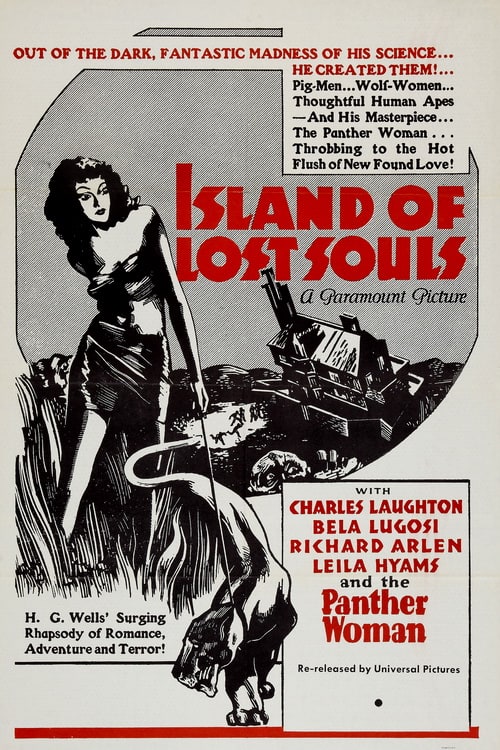
The screenplay was co-authored by
Phillip Wylie. As a novelist Wylie co-wrote with
Edward Balmer the classic
1933 science fiction work
"When Worlds Collide" and its sequel
"After Worlds Collide". Phillip Wylie had not received on screen credit for the screenplay to
1933's, "The Invisible Man". Which he wrote with the fully credited,
R.C. Sheriff, who co-wrote,
1935's, "The Bride of Frankenstein", and
1936's, "Dracula's Daughter".
For this film, Wylie co-authored the screenplay with Waldemar Young. Young had written the screenplays for the Todd Browning, Lon Chaney, 1927 vehicles "The Unknown" and "London After Midnight". He additionally wrote Cecil B. DeMille's 1932, "The Sign of the Cross", and 1934's, "Cleopatra", both starring Claudette Colbert.
Charles Laughton portrayed "Dr. Moreau". At the time Laughton had just been seen as "Emperor Nero Claudius Caesar" in Cecil B. DeMille's, 1932's, "The Sign of the Cross". In 1933, Laughton won the "Best Actor Academy Award" for "The Private Lives of Henry the VIII". The movie featured his actual wife, actress Elsa Lanchester portraying "Anne of Cleves". In 1935, Charles Laughton portrayed "Inspector Javert" in Victor Hugo's, "Les Miserables", opposite Frederic March.

Richard Arlen portrayed
"Edward Parker". Arlen co-starred in the first
"Academy Award for Best Picture" winner, director
William Wellman's, 1927's, "Wings". He had co-starred with
Gary Cooper and
Walter Huston, in
1929's, "The Virginian". Richard Arlen had the interesting role of
"The Cheshire Cat", in
Paramount Pictures, all star live action,
1933, "Alice in Wonderland".
"The Sayer of the Law" was portrayed by Bela Lugosi. The year before, Lugosi had been seen in both the first Zombie movie, "White Zombie" and Edgar Allan Poe's, the "Murders in the Rue Morgue".
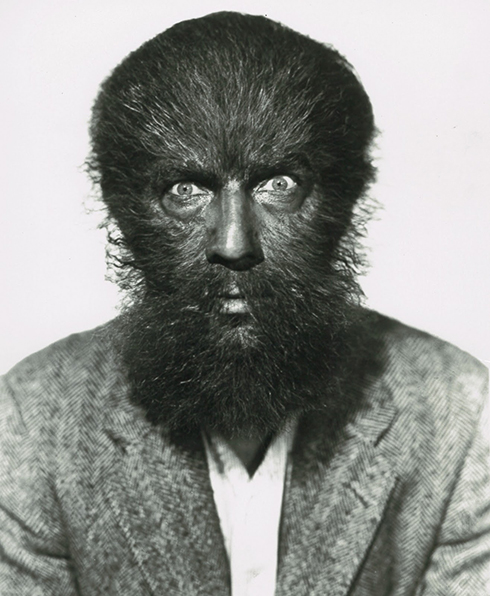
Below how
Bela was billed during the opening on-screen credits for
"Island of Lost Souls".
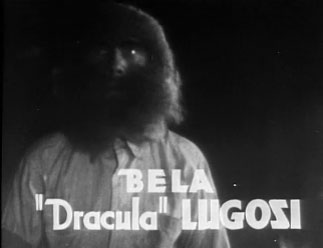
Many movies,
"White Zombie" was one, from studios other than
Universal Pictures were billing
Lugosi as
"Bela 'Dracula'" Lugosi". Which indicated the publicity power of that
1931 role. However, as many of my readers know, it became a curse on the actor to get away from being stereotyped.
This was
Kathleen Burke's first motion picture and the model turned actress portrayed
"Lota, the Panther Women", the
"Puma Women" of
H.G. Wells's novel.
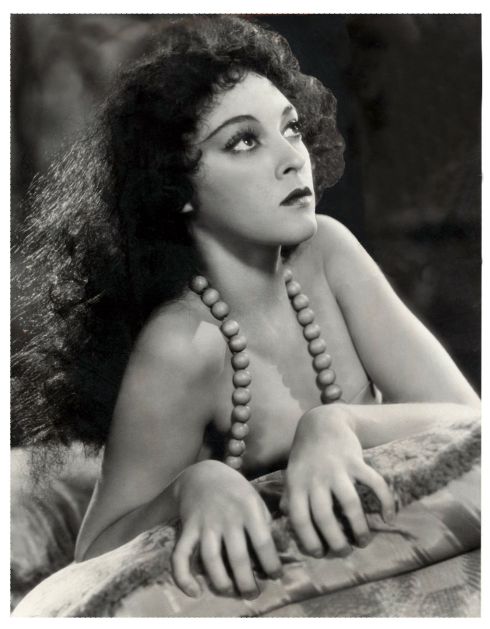 The Screenplay:
The Screenplay:Shipwrecked "Edward Parker" is rescued by a merchant ship that is carrying animals to
"The Island of Dr. Moreau". On board, "Parker" meets
"Mr. Montgomery", portrayed by,
Arthur Hohl, and his assistant the "Bestial"
"M'Liing", portrayed by
Tetsu Komai. Later
"Captain Davies", portrayed by
Stanley Fields, wants to get rid of "Parker" and tosses him into the boat with "Montgomery" and "M'Ling".

Above
Tetsu Komai as
"M'Ling"."Parker" is welcomed by "Dr. Moreau", who offers him the hospitality of his home. "Moreau" also introduces "Edward" to "Lota", a very beautiful, but seemingly simple girl.

When "Edward" and "Lota" hear screams coming from a locked room. The girl tells "Parker" that is the "House of Pain". He decides to investigate and finds "Dr. Moreau" and "Montgomery" operating, without anesthetic, upon what appears to be a man
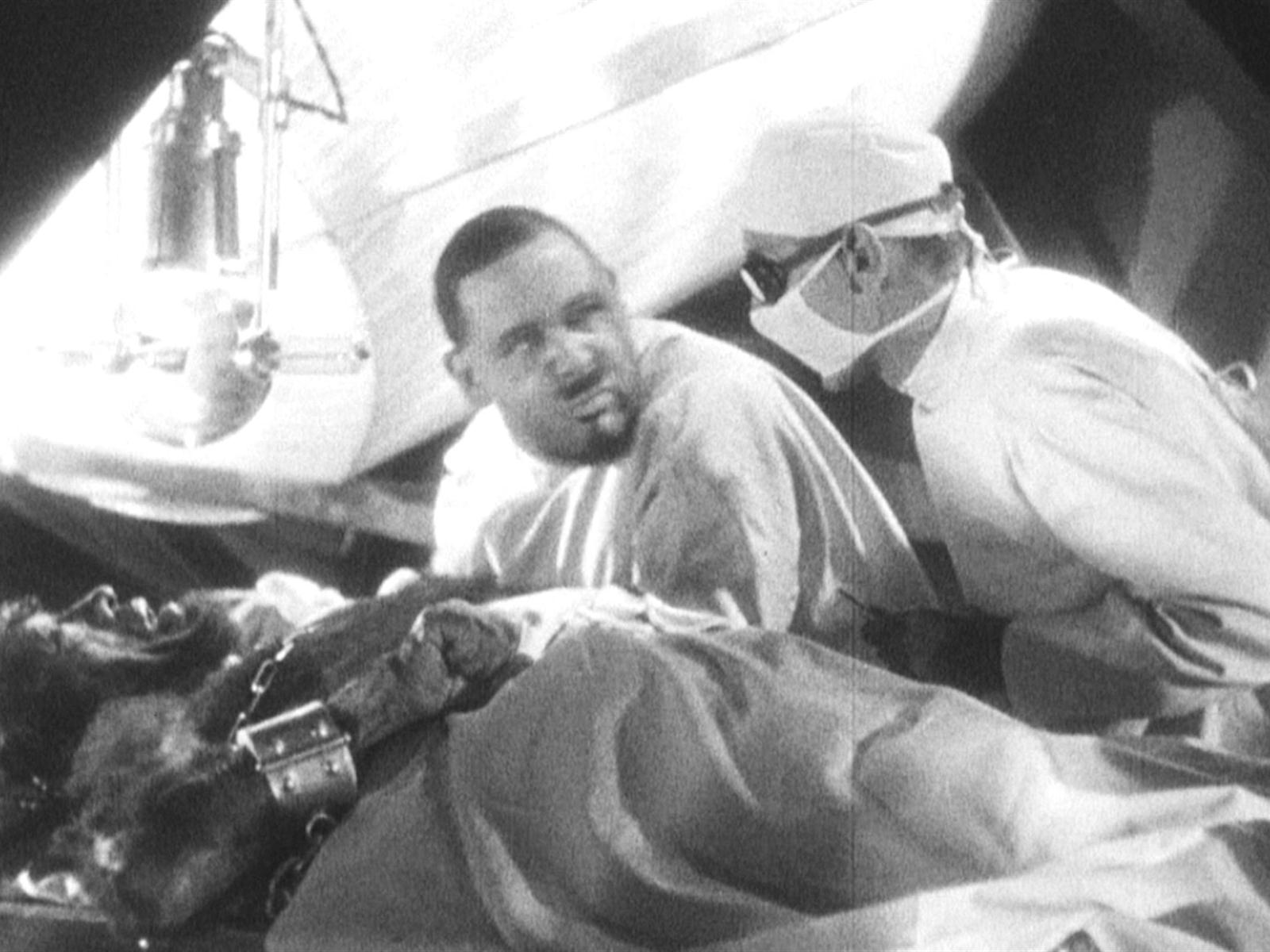
To "Edward Parker", it appears the two men are performing a sadistic vivisection of a human being. He attempts to flee, but outside the compound. He meets strange, almost animal like, men coming out of the jungle. "Moreau" appears, cracks his whip and orders the "Sayer of the Law" to repeat the rule against violence.
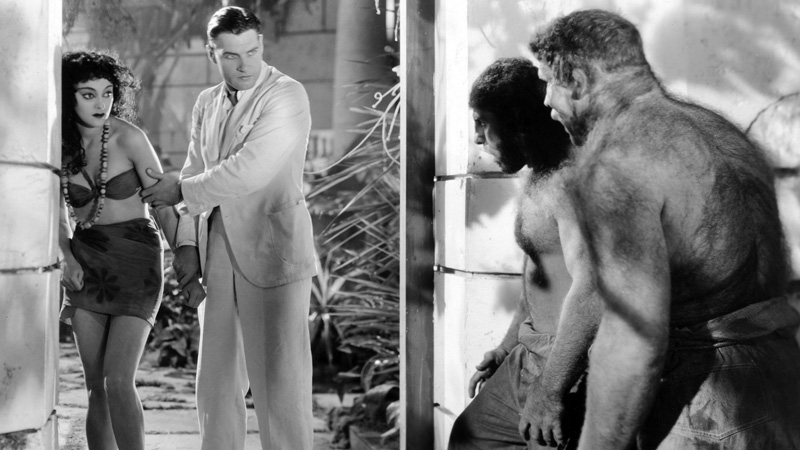

Back inside the house, "Dr. Moreau" explains that back in London he started experimenting on plants to speed up the evolutionary process and moved to animals. What "Parker" mistook for human beings, are actually animals. That the doctor experimented upon to speed up their evolutionary processes. "Moreau" reveals to "Parker" that "Lota" is the sole woman upon his island, but leaves out the fact she was originally a panther.
The following are a few of the other
"Beast Folk" and the work of the two
uncredited make-up artists, Charles Gemora, and
Wally Westmore.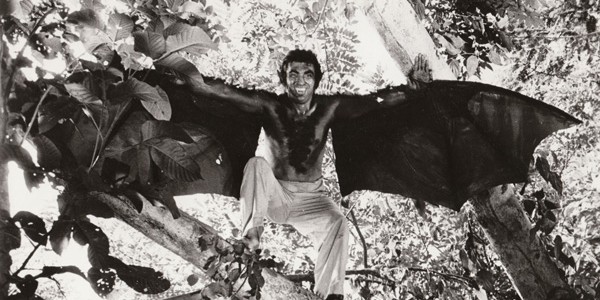


"Parker" is falling in love with "Lota", but has a fiancée named
"Ruth Thomas", portrayed by
Lelia Hymns, that he left back in Samoa.
"Edward" eventually finds out the truth about "Lota". After they hug and her fingers have become more claw like. He confronts "Dr. Moreau" and is told that the girl is the most perfect creature he has created. The doctor was hoping someone would fall in love with her and he would see, if she had truly become human like, and have children. However, "Moreau" is upset that "Lota" is starting to revert back to her true animal form.
Meanwhile, the American Consul at Apia, Samoa, has learned of "Edward Parker's" whereabouts and convinces
"Captain Donahue", portrayed by
Paul Hurst, to take "Ruth" to the island. Where she is reunited with "Edward", but because of the very late hour. For their safety, "Dr. Moreau" convinces the three to stay the night.

In reality, "Dr. Moreau" wants to see if one of his Beat-Men can mate with "Ruth". At the same time he sends
"Ouran", portrayed by
Hans Steinke, to murder "Donahue".

Both actions become violations of the law as seen by the "Beast Folk". They no longer feel bound to "Dr. Moreau" and revert to their true animal nature.When confronted, "Dr. Moreau" asks:
What is the law?
The reply is:
The Law is no more!
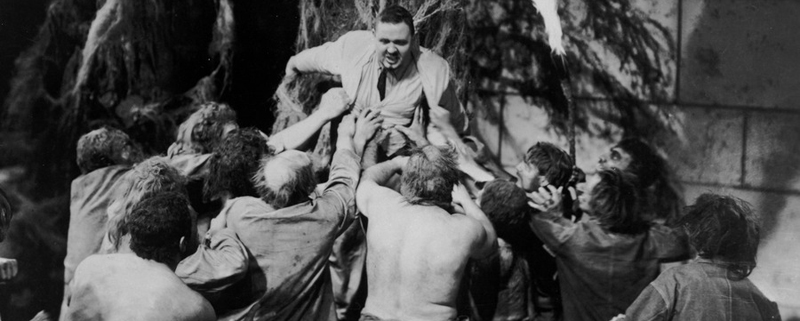
"Montgomery" is fed up and helps the three to get off the island as "Dr. Moreau is killed. "Edward" wants to take "Lota" with them, but "Ouran" attempts to stop them and "Lota" fights the other. Both are killed as a result of their injuries. As the boat leaves the island the compound is shown in flames.
H.G. Wells hated the movie and strongly would tell that to those who would listen him. About how the screenplay destroyed the philosophical message of his story for horror. However, fans disagree and the film holds, as of this writing, a 96 percent rating on Rotten Tomatoes.
Víctor-Marie Hugo, vicomte Hugo, was a French politician, novelist, poet, and dramatist.
On March 16, 1831, Victor Hugo published a French gothic novel, originally entitled, "Notre-Dame de Paris (Our Lady of Paris), 1482". Which gave the reader the specific year his story takes place, but the year was removed for the second printing. Later, the entire title would be changed once again. Reflecting one of his novel's two major characters, and it became "The Hunchback of Notre-Dame".
The 1939 motion picture version of Victor Hugo's novel, is still considered by many film historians as the definitive screen version. It was also a major Hollywood motion picture in a year dominated by "Gone With the Wind", "The Wizard of Oz", John Ford's "Stagecoach", and Frank Capra's "Mr. Smith Goes to Washington".
THE HUNCHBACK OF NOTRE-DAME premiered at the Cannes Film Festival on August 31, 1939
The following with minor changes, came from my comprehensive article "Victor Hugo's Immortal Love Story: THE HUNCHBACK OF NOTRE-DAME on the Motion Picture Screen" for my readers at:
In 1939 Hollywood was now working under the "Motion Picture Production Code of 1934", or in short, major censorship. For example, specific changes needed to be made to Victor Hugo's characters of the "Frollo" brothers, see next paragraph, as compared to who they were in the novel. The 1923 production, starring Lon Chaney, wasn't under the "Code", but "Universal Picture's" had made some changes to these same characters, but for narrative purposes only. While, the 1939 changes were for the protection of American Morality. As determined by the powerful chief government censor, Will H. Hays, of what was now called "The Hays Office". That would rule the American film industry for the next 20-years.
For the 1939 production, the novel was adapted by Bruno Frank. Frank changed "Archdeacon
Claude Frollo" from a villainous priest to a good man and promoted him to
"Archbishop". Leaving
Victor Hugo's original character in place would have brought down the wrath of the
"Catholic League of Decency" and other Christian religious groups. The age of his brother
"Jehan", as in
1923, was raised from a teenager to that of an older man and his first name was now changed to
"Jean".
Frank added that
"Jean" was also now French monarch,
Louis XI's, "Chief Justice of Paris". Thus putting the new
"Jean Frollo", in charge of prosecuting all crimes in Paris, and, again, as in
1923, the villain of the film, instead of being a troubled teenager.
William Dieterle was the director of the feature. His
"Life of Emile Zola", starring
Paul Muni, had won the
1937 Best Picture Oscar. Prior to this motion picture
Dieterle directed the historical
1939, "Juarez", starring
Muni and
Bette Davis. He followed this feature film with
1940's, "Dr. Ehrlich's Magic Bullet", starring
Edward G. Robinson. Charles Laughton portrayed
"Quasimodo". Laughton was once again nominated for the
"Best Actor Academy Award", for his role as
"Captain Bligh" in
1935's, "Mutiny on the Bounty".
Maureen O'Hara was "Esmeralda". This was O'Hara's fourth film role and the second picture that
"Maureen FitzSimmons" was known as "Maureen O'Hara". FitzSimmons first movie as O'Hara had her appearing opposite Charles Laughton, in director Alfred Hitchcock's adventure film, 1939's,
"Jamaica Inn", with Robert Newton as her love interest.
+101.jpg)
Alan Marshall was
"Captain Phoebus". Marshall was a stage actor who appeared in several motion pictures. This same year he appeared in
"The Adventures of Sherlock Holmes" starring
Basil Rathbone,
Nigel Bruce, and
Ida Lupino. Sir Cedric Hardwicke
Sir Cedric Hardwicke was now
"Jean Frollo". In
1935, he was in
Victor Hugo's "Les Miserables" portraying
"Bishop Bienvenue". In
1936, Hardwicke appeared in one of two motion pictures written by
H.G. Wells ,"Things to Come", starring
Raymond Massey. In
1937, he was
"Allan Quartermain", in the excellent and forgotten British production of
"King Solomon's Mines", co-starring the great African American singer
Paul Robeson. Walter Hampden
Walter Hampden was now
"Archbishop Claude Frollo". Hampden was both a major Broadway actor and theater manager.
 Thomas Mitchell
Thomas Mitchell was
"Clopin". He would win the
"Best Supporting Actor Academy Award" as
"Doc Josiah Boone", in
John Ford's, 1939, "Stagecoach". Also in
1939, he was
"Diz Moore" in
Frank Capra's, "Mr. Smith Goes to Washington", and
"Gerald O'Hara" in
"Gone with the Wind".
 Edmond O'Brien,
Edmond O'Brien, in his first motion picture role, portrayed
"Pierre Gringiore". His next feature film was the comedy-romance,
1941's, "A Girl, A Guy, and a Gob", co-starring in this forgotten picture with
George Murphy, and
Lucille Ball.
Henry Davenport portrayed the kindly
"King Louis XI". The character actor was known for playing country doctors, grandfathers, judges and ministers.
 The motion picture opens with a written prologue:
The motion picture opens with a written prologue:With the end of the 15th century, the Middle Ages came to a close. Europe began to see great changes. France, ravaged by a hundred years war, at last found peace. The people under Louis XI felt free to hope again ~ to dream of progress. But superstition and prejudice often stood in the way, seeking to crush the adventurous spirit of man.

A series of seemingly unrelated events follows the written prologue. As first the audience meets "Jean Frollo", who is determine to stop anything HE deems evil from entering Paris. This includes printing presses and gypsies without a permit. "Frollo" visits a print shop as the picture opens. It is also the
"Day of Fools" and playwright,
"Pierre Gringiore", is performing a play until it is interrupted by "Clopin", the leader of the Paris thieves. The play is replaced by the young gypsy woman "Esmeralda" as she dances.
Next, the bell ringer of Notre Dame Cathedral, "Quasimodo", is crowned "King of Fools", but "Jean Frollo" drags him away and back to the cathedral.


The following day, "Esmeralda" seeks out "King Louis XI", to ask him to protect her people. However, she is captured by some guards for entering Paris without a permit. The girl escapes them, runs into Notre Dame, and is given sanctuary by "Archbishop Claude Frollo". A short while later, the Archbishops brother, "Jean Frollo", confronts "Esmeralda", and calls her a heathen.

Later, within Notre Dame, "Esmeralda" meets the kindly "King Louis XI", who agrees to help the gypsies. Afterward, "Jean Frollo" takes the girl up into one of the church towers. On the way up, the two encounter "Quasimodo", who frightens her. "Esmeralda" turns, and runs away from her sanctuary and the church. "Jean Frollo" orders "Quasimodo" to go after the girl and
bring her back to him. 
"Pierre Gringorie" witnesses the chase and goes for "Captain Phoebus". Who gets his guards and goes after "Quasimodo". He is captured and the love story between "Esmeralda" and "Phoebus" begins.

Later, "Gringorie" accidentally enters the beggars,
"Court of Miracles", and is saved from death, by "Esmeralda", who agrees to marry him. "Pierre" takes this seriously, but "Esmeralda" tells him it was just to save him and she loves another.
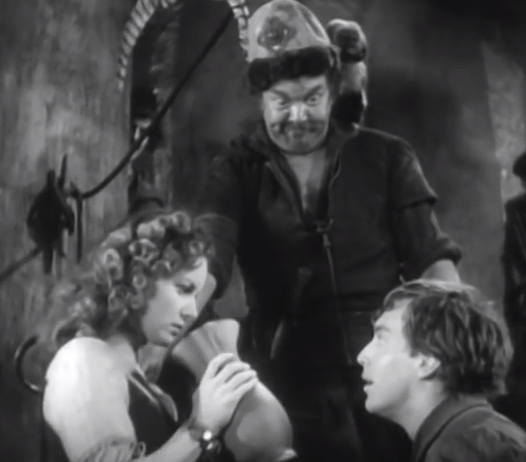
The next day, for his crime, "Quasimodo" is sentenced to be lashed and publicly humiliated. "Jean Frollo" doesn't help the confused bell ringer and ignores his pleas. During his lashings "Quasimodo" asks for water, but not one person comes to his aide until "Esmeralda" appears.



Later "Phoebus" invites "Esmeralda" to a party with the nobles. At the party, "Jean Frollo" turns up, and he confesses his evil lust for the girl.

"Phoebus" approaches the two, and with "Esmeralda", they go off together.
In a rage, "Jean Frollo" kills him and then puts the blame upon the gypsy girl.
"Jean" confesses to his brother the "Archbishop", but his brother will not help him as he's a murderer. "Gringorie" attempts to get his "wife" freed, but to no avail. Even after "Archbishop Claude Frollo" proclaims her innocence. A trial is held and "Esmeralda" is sentenced to death.

As she is led on a cart to the execution site surrounded by the "Good" citizens of Paris. Suddenly, "Quasimodo" comes down from the bell tower of Notre Dame, and grabs "Esmeralda". He takes her into the cathedral, and up to his bell tower. While holding "Esmeralda" up,
"Quasimodo" calls for "Sanctuary", to the cries of delight by the Paris crowd and the beggars.
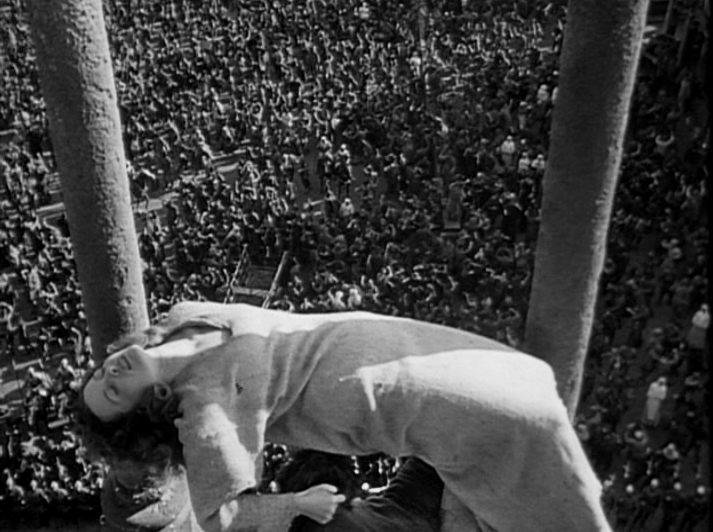
"Quasimodo" attempts to befriend "Esmeralda" and tells her of how the bells, that he loves, made him deaf.

This leads to a second series of events. "Gringorie" prints a pamphlet to save "Esmeralda" and for the gypsies to have the same rights as citizens. He is able to get it to the King to agree. However, the beggars, under "Clopin", attack Notre Dame to save "Esmeralda" and "Quasimodo", and the guards fight them off.
As the battle is occurring, the bell ringer sees "Jean Frollo" harming the gypsy girl. "Quasimodo" throws "Jean Frollo" off the battlements to his just reward.
The King frees "Esmeralda" and the gypsies, and the girl has come to love the poet.
The film ends with "Quasimodo" up in his tower by one of the gargoyles. He is talking to it of his love for "Esmeralda" and says:
Why was I not made of stone, like thee?".
Mention the name of Scottish writer Robert Lewis Stevenson, and more than likely, his 1883 novel, "Treasure Island" will come up. Along with both 1886's, "The Strange Case of Dr. Jekyll and Mr. Hyde", and "Kidnapped". Probably, because all three have been made into many motion pictures since the silent era. Then, if you're a fan of producer Val Lawton, you might mention "The Body Snatcher", directed by Robert Wise, and in the title role, Boris Karloff, that novel was published in 1884. All bringing my reader, and Karloff to Stevenson's, 1878 short story, "The Sire de Maletroit's Door". Which is the basis for my last movie starring Charles Laughton.
However, shortly before filming began on May 15, 1951, Charles Laughton completed ten live audience readings from his favorite subject, "the Bible". For those who might be interested, there are several different recording available of Laughton's selected bible readings.
THE STRANGE DOOR premiered in Marion, Ohio, on October 27, 1951
The screenplay was by Jerry Sackheim, who immediately followed this picture with the similar 1952, "The Black Castle". Sackheim was a "B" screenplay writer that started in 1934, and would write 4-episodes for television's "Science Fiction Theatre". During that programs initial 1955 first season. For producer Bert I. Gordon, Jerry Sacheim wrote the screenplay for 1960's, "The Boy and the Pirates".
The motion picture was directed by Joseph Pevney. Pevney was a "B" director with several very good "B plus" motion pictures mixed in with his television work. He immediately followed "The Strange Door", with the Frank Sinatra and Shelley Winters, 1952, "Meet Danny Wilson". In 1954, it was the Dean Martin and Jerry Lewis, "3 Ring Circus", the following year, the Tony Curtis and Julie Adams, "Six Bridges to Cross" about the 1950, "Brinks" robbery, and in 1957 there were two major hits. The first was the Debbie Reynolds and Leslie Nielson, "Tammy and the Bachelor". The second starred James Cagney portraying Lon Chaney, Sr. in "The Man of a Thousand Faces", co-starring with both actresses, Dorothy Malone and Jane Greer.
Charles Laughton portrayed "Sire Alain de Maletroit". Laughton had, according to film historian Tom Weaver, just co-starred with Jane Wyman and Joan Blondell, in 1951's, "The Blue Veil", and would follow this feature with 1952's, "O. Henry's Full House". That contained five stories by short story writer William Sydney Porter, known by his pen-name of "O. Henry". Each of the five stories were written by nine different writers and the segments were directed by five different major directors. All narrated by author John Steinbeck and with a cast headed by 12-Hollywood major actors and actresses.

Boris Karloff portrayed "Voltan". Karloff had just been seen in Season Three, Episode Four, of Arch Obler's television series based upon his radio program, "Lights Out", entitled "The Leopard Lady". He followed this feature film appearing on the dramatic television series, "CBS Television Workshop", in the title role of Spanish writer, Miguel de Cervantes's, "Don Quixote", and co-starring, the still unknown, Grace Kelly. My article is "Boris Karloff: There Was More Than Horror Movies (January 15, 1919 to July 20, 1958)" at:
Sally Forrest portrayed "Blanche de Maletroit". Forrest started out as an uncredited dancer in 1946's, "Till the Clouds Roll By", and continued in that type of roll for her next three motion pictures. She stayed basically a "B" actress, but one of her films is of interest to my reader. This was the Howard Hughes, 1955 production of "Son of Sinbad". That had the actress co-starring with Dale Robinson, Vincent Price, and as the lyric in Richard O'Brien's, "The Rocky Horror Picture Show", says, "God Bless Lili St. Cyr".
Richard Stapley portrayed "Denis de Beaulieu". Essex, England, born, Stapley couldn't get his acting career in the United States going beyond minor supporting roles. He returned to England in 1960 and to distance himself from the American roles. Richard Stapley took the stage name of Richard Wyler, and had the same problems appearing in films in the United Kingdom. He next went to Italy and Spain and either starred, or co-starred in a series of Sword and Sandal pictures and Spaghetti Westerns.

Alan Napier portrayed "Count Grassin". Napier had also just been seen in 1951's, "The Blue Veil", and followed this feature film portraying British author Charles Dickens in televisions "Fireside Theatre", Season Four, Episode Eighteen, "A Christmas Carol". Napier mainly appeared on television, but among his motion pictures is the classic, 1959 version, of French author, Jules Verne's, "Journey to the Center of the Earth", director Roger Corman's, 1962 version of, Edgar Allan Poe's, "The Premature Burial", and director Alfred Hitchcock's, 1964, "Marnie". Of course I could not forget Alan Napier as "Alfred", on television "Batman", from 1966 through 1968, for 122-episodes.
Above, that's Richard Stapley speaking to Alan Napier, whose character will get the same treatment as Stapley's would at the film's climax, but with different results.
Michael Pate portrayed "Talon". Pate's next movie was 1952's, "The Black Castle", fans of John Wayne know Michael Pate portraying "Vittorio" in the 1953, 3-D, western, "Hondo". Another classic role for the actor is the vampire, in the 1959 western co-starring Eric Fleming, "Curse of the Undead". My article is "Woody Strode and Michael Pate: Western Stalwarts" available for readers at:
The Basic Screenplay:
Charles Laughton had fun hamming up "Alain" and it works, especially with some of the lines he's given. This "Universal International" period piece is a lot better than you may think.
Twenty-years before the main story begins, "Alain's" brother, "Edmond", portrayed by Paul Cavanagh, steals "Alain's" childhood sweetheart. Later she died in childbirth giving birth to her's and "Edmond's" daughter, "Blanche". "Alain" plots his revenge in stages, by first having "Edmond" locked up in a cell in the dungeon.
Switch to 20-years later, the story actually begins with "Blanche" convinced by her uncle, that her father has been dead all those years. "Alain" has been waiting to find a way, in his warped mind, to truly get revenge on his brother by using "Blanche". Now, a young man, who seems the perfect chess piece for the second part of "Alain's plan, has appeared. He the high born, but always drunken, "Denis de Beaulieu".
Unknown to "Alain" over the past 20-years, is that "Edmond" has been kept appraised of his daughter's life by his old and loyal servant and now his jailer, "Voltan".
While, at the "Le Lion Rogue", "Denis de Beaulieu", is about to be framed for murder.
"Sire Alain de Maletroit" has this person leave a pistol in plain sight for drunken "Denis de Beaulieu" to grab and use during an altercation with another man.
"Denis" uses the pistol and the man falls dead to the floor, but what he doesn't know is that the pistol has no bullet, only gun power. The owner of the pistol examines the dead man and starts yelling to get "de Beaulieu", who in his drunken state, runs out of the inn with a mob following.
The mob as planned and paid off, now chases the presumed murderer into the countryside in a precise direction. The mob finally disbands and "Denis de Beaulieu", finds himself starring at a castle-like-mansion.
Next, the title of the motion picture kicks in, as the conveniently unlocked exterior front door beckons to "Denis" and he enters. This is "The Strange Door", because once inside, he finds there is no latch to reopen it and leave.
"Alain" now reveals to "Denis" his grand plan of revenge and that he is his prisoner. "Alain" will force "Denis" and "Blanche" into marriage. After which, he will reveal this to his brother in his cell, that will finish turning "Edmond" into a raving madman. However, who is really the mad brother?
The cleaned up "Denis" is introduced to "Blanche" and both are against any marriage, but "de Maletroit" would not hear of that and ruin his revenge. Meanwhile, "Voltan" having heard all of this, the servant, and jail keeper, knows all the secret passage ways and peepholes of the castles.
"Voltan" informs "Edmond" and is asked to murder "Denis de Beaulieu". However, by this time, it now turns out that "Blanche" and "Denis" have actually fallen in love. An unexpected development in the plans of "Sire Alain de Maletroit" and "Voltan's" orders to murder "Denis". "Voltan", who has a fatherly soft spot for "Blanche de Maletroit", listens to her plea not to kill her love. He agrees and tells her father, who he has never revealed to "Blanche" is still alive in the dungeon.
There is a wedding reception hosted by "Sire Alain de Maletroit" to announce the marriage of his niece to "Denis de Beaulieu".
Trivia:
Above in an uncredited, no name role, in her first on-screen appearance, not always listed, is 1950's, science fiction and horror queen, Allison Hayes. I could not identify the man dancing with her.
Later, "Alain" reveals to "Blanche" and "Denis", a portrait of her mother that he has kept. Her mother's face is "Blanche's" face and now the final part of his plan is put into effect.
"Denis" and "Blanche" attempt to escape from "Alain", but that is stopped by "Alain's" men.
Under guard, "Blanche" and "Denis" are taken to "Alain". Who is standing next to a large waterwheel on an underground river.
The two are placed in the same cell with "Blanche's" father "Edmond" and a reunion of father and daughter "tenderly" occurs.
Next, the purpose of the waterwheel becomes known, as "Alain" starts it up and the walls of the cell start to close upon the three prisoners. However, "Voltan" attacks "Alain" and a fight by the waterwheel starts. "Voltan" is mortally wounded as the two men fall into the river. The very overweight "Sire Alain de Maletroit" is pushed by "Voltan" into one of the waterwheel's sections and can't get himself loose. The wheel continues to turn, reaches the obstruction of "Alain", and crushes him to death.
Because of the obstruction of the fat "de Maletriot", the walls of the cell have stopped closing upon its three victims. Suddenly, having cleared "Alain de Maletroit" out, whose body now floats in the river. The water wheel starts to slowly move once more and the walls to move, but "Voltan" appears and in his last dying breath, tosses the keys to "Denis".
"Edmond", the new lord of the castle, has the strange door replaced with one that allows entering and exiting. While, the newly weds, "Blanche" and "Denis" look upon their future together.
"The Strange Door" and 1952's, "The Black Castle", starring Richard Greene, Boris Karloff, Stephen McNally, Rita Corday billed as Paula Corday, and Lon Chaney, Jr., was planned as a restart of "Universal International Pictures" horror movies of the previous decades. However, both were box office failures, because as a result of "The Second Red Scare", the audiences were into science fiction films. The studio's first entry in the new category was, technically, 1951's, "Abbott and Costello Meet the Invisible Man". The studio's next entry was 1953's, "Abbott and Costello Go to Mars". There first pure science fiction entry was the 3-D entry, 1953's, "It Came from Outer Space".



















+101.jpg)





















.jpg)
.jpg)













































_02.jpg)











































No comments:
Post a Comment